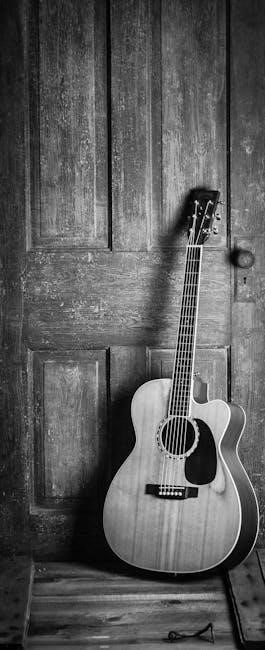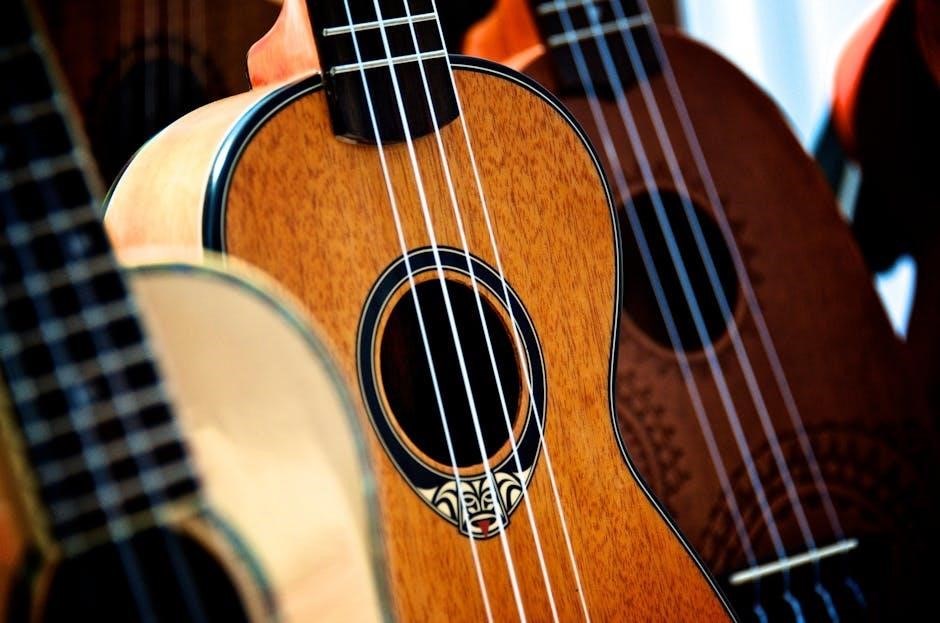
Guitar string gauge refers to the thickness of a string‚ measured in thousandths of an inch. It significantly impacts playability‚ tone‚ and overall guitar setup efficiency.
1.1 Definition of String Gauge
Guitar string gauge refers to the thickness or diameter of a guitar string‚ measured in thousandths of an inch. For example‚ a 0.009-inch string is referred to as a “nine.” Gauges range from light (e.g.‚ 0.009–0.042) to heavy (e.g.‚ 0.011–0.052)‚ with medium gauges (e.g.‚ 0.010–0.046) being a popular choice. The gauge affects playability‚ tone‚ and string tension‚ making it a critical factor in guitar setup and performance. Proper gauge selection ensures optimal sound and playing comfort.
1.2 Importance of String Gauge in Guitar Setup
String gauge plays a critical role in guitar setup‚ influencing neck relief‚ string action‚ and overall playability. Proper gauge selection ensures the guitar’s neck remains stable‚ avoiding issues like excessive bowing or buzzing. Heavier gauges require adjustments to neck relief and bridge setup to maintain optimal performance. Correct string tension prevents tuning instability and fretting difficulties‚ ensuring a smooth playing experience. The right gauge balances technical requirements with personal playing style‚ making it essential for achieving both comfort and tone quality.

Factors Influencing String Gauge Choice
Factors such as playability‚ sound quality‚ string tension‚ and guitar type significantly influence string gauge selection‚ ensuring optimal performance tailored to the player’s needs and preferences.
2.1 Playability and Comfort
String gauge significantly impacts playability and comfort‚ as thicker strings require more finger strength and may cause fatigue. Lighter gauges are ideal for beginners or those with less hand strength‚ offering easier bending and pressing. However‚ they may lack the sustain and tone of heavier strings. Thicker gauges provide better resonance but can be challenging for intricate playing styles. Balancing string thickness with personal comfort ensures a smoother playing experience‚ making it essential to choose a gauge that suits both skill level and musical style.
2.2 Sound Quality and Tone
String gauge plays a crucial role in determining the sound quality and tone of a guitar. Lighter gauges produce a brighter‚ snappier sound with less sustain‚ while heavier gauges deliver warmer‚ fuller tones with increased sustain. Thicker strings often enhance low-end response and harmonic richness‚ making them ideal for genres requiring heavy distortion or deep resonance. However‚ lighter strings can provide clarity and articulation‚ especially in genres like jazz or fingerstyle. The right gauge balances tone preferences with playing comfort‚ ensuring optimal sound for various musical styles.
2.3 String Tension and Guitar Type
String tension varies with gauge‚ affecting playability and sound. Heavier gauges increase tension‚ providing stability for lower tunings like drop C‚ while lighter gauges reduce strain on the neck. Electric guitars‚ with their fixed bridges‚ handle heavier strings well‚ while acoustics may require lighter gauges to avoid excessive stress on the soundboard. Tension impacts tuning stability‚ especially with detuning‚ making gauge selection crucial for maintaining pitch accuracy and optimal performance across different guitar types and playing styles.

Standard String Gauges for Electric and Acoustic Guitars
Standard string gauges vary for electric and acoustic guitars‚ ranging from light (0.009-0.042) to heavy (0.011-0.052). These sets balance playability‚ tone‚ and guitar type-specific needs effectively.
3.1 Light Gauge Strings (e.g.‚ 0.009 ‒ 0.042)
Light gauge strings‚ such as 0.009 to 0.042‚ are ideal for beginners and players seeking ease of playability. They reduce finger fatigue and are suitable for fast‚ intricate playing styles. These strings produce a bright‚ crisp tone with good sustain‚ making them popular for genres like rock‚ jazz‚ and pop. Lighter gauges are also less likely to cause fret buzzing‚ especially on guitars with low action. However‚ they may lack the depth and warmth of heavier strings.
3.2 Medium Gauge Strings (e.g.‚ 0.010 ― 0.046)
Medium gauge strings‚ such as 0.010 to 0.046‚ offer a balanced feel and tone‚ making them a popular choice for many players. These strings provide easier playability than heavy gauges while delivering more sustain and warmth than light gauges. They are versatile‚ suitable for various musical genres‚ and work well for both electric and acoustic guitars. Medium gauges are ideal for players who want a compromise between comfort and sound quality‚ offering a responsive feel without sacrificing depth in tone.
3.3 Heavy Gauge Strings (e.g.‚ 0.011 ‒ 0.052)
Heavy gauge strings‚ ranging from 0.011 to 0.052‚ are designed for players seeking robust tone and sustain. These thicker strings produce fuller‚ richer sounds with increased clarity in the lower frequencies. They are ideal for genres like rock‚ metal‚ and jazz‚ where a strong‚ resonant sound is desired. However‚ they may be less comfortable for beginners due to higher tension‚ requiring more finger strength. Proper guitar setup is crucial to avoid issues like string buzz or intonation problems with heavy gauges.
3.4 Custom and Specialty Gauges
Custom and specialty gauges offer tailored string sets for specific needs‚ blending different thicknesses to optimize tone and playability. These gauges cater to unique playing styles‚ tunings‚ or musical genres‚ allowing players to experiment beyond standard sets. For example‚ a mix of light and heavy strings can balance ease of bending with robust low-end clarity. Specialty sets often include coated strings for longevity or unique materials like flatwounds for smooth playability. They provide versatility for artists seeking distinct sonic characteristics or technical advantages in their music.

How to Choose the Right String Gauge
Choosing the right string gauge involves balancing playability‚ sound quality‚ and setup. Lighter gauges ease bending but may lack sustain‚ while heavier gauges offer fuller tone but increased difficulty.
4.1 Skill Level and Playing Style
Skill level and playing style significantly influence string gauge selection. Beginners often prefer lighter gauges for easier playability‚ while experienced players may opt for heavier gauges for better tone and sustain. Lighter strings reduce finger fatigue‚ making them ideal for intricate techniques like bending. Heavier gauges‚ though harder to press‚ deliver fuller sound and are often favored by seasoned musicians. Ultimately‚ the choice depends on balancing comfort with desired tonal output‚ making it essential to experiment and find the right fit for individual needs and preferences.
4.2 Musical Genre and Tuning Preferences
Musical genre and tuning preferences play a crucial role in selecting string gauge. Heavier gauges are often preferred for genres like metal and hard rock‚ especially in lower tunings‚ as they provide increased sustain and stability. Lighter gauges‚ such as 0.009-0.042‚ are ideal for jazz‚ blues‚ and standard tuning‚ offering ease of bending and a brighter tone. For drop tunings‚ medium to heavy gauges (0.010-0.052) are recommended to maintain clarity and prevent floppiness. Matching the string gauge to the genre and tuning ensures optimal sound and performance.
Guitar Setup and String Gauge
Guitar setup adjustments‚ such as neck relief and string action‚ are crucial when changing string gauges to ensure proper playability and avoid issues like string buzz or tuning instability.
5.1 Adjusting Neck Relief and String Action
Proper neck relief and string action are vital when changing string gauges. Heavier strings increase tension‚ requiring more neck relief to prevent buzzing. String action at the 7th fret should be 0.059 to 0.078 inches for the low E string. Adjustments ensure comfortable playability and optimal sound quality. Incorrect settings can lead to tuning issues and discomfort‚ making precise measurements essential for a professional setup.
5.2 Intonation and Bridge Setup for Different Gauges
Intonation accuracy depends on string gauge and bridge setup. Thicker strings require bridge adjustments to maintain proper intonation‚ as their higher tension alters string length. Improper setup leads to pitch inaccuracies‚ especially on heavier gauges. Adjusting the bridge ensures each string plays in tune across the fretboard‚ essential for clear tone and precise tuning. Regular checks and precise calibration are crucial for optimal performance‚ particularly when switching between light and heavy gauges.

Impact of String Gauge on Tone
String gauge significantly influences tone‚ with lighter gauges producing brighter‚ trebly sounds and heavier gauges yielding warmer‚ fuller tones. The right gauge enhances sustain and harmonics effectively.
6.1 Material and Winding Types
String material and winding significantly impact tone. Nickel-plated strings offer warmth‚ while stainless steel provides brightness. Titanium strings deliver clarity and durability. Roundwound strings produce a bright‚ aggressive tone‚ whereas flatwound strings offer a smooth‚ mellow sound. Coated strings‚ like Elixir’s Nanoweb‚ reduce finger noise and extend lifespan. The combination of material and winding type tailors the tone to suit various musical genres and playing styles‚ making them essential considerations in achieving desired sound quality and sustain.
6.2 Role of String Gauge in Sustain and Harmonics
String gauge influences sustain and harmonic response. Heavier gauges generally produce longer sustain due to increased string tension‚ allowing notes to ring out clearly. Thinner strings‚ while easier to bend‚ may lack sustain. The material and winding type also play roles‚ with roundwound strings enhancing harmonics. Proper gauge selection balances playability and desired tonal characteristics‚ ensuring optimal sustain and harmonic richness for various musical applications and stylistic preferences‚ enhancing overall performance quality and musical expression.
Common Issues with String Gauge
Common issues include string buzz‚ tuning instability‚ and fretting difficulties. Proper setup and gauge selection are crucial to avoid these problems and ensure optimal performance and sound quality.
7.1 String Buzz and Fretting Difficulties
String buzz occurs when strings vibrate against the frets‚ causing unwanted noise. Incorrect string gauge or low action can exacerbate this issue. Fretting difficulties arise when strings are too thick‚ making chords and bends challenging. Lighter gauges reduce finger fatigue but may buzz if action is too low. Proper setup‚ including neck relief and string height adjustment‚ is essential to resolve these issues and ensure smooth playability and clear tone. Heavier strings can also increase tension‚ complicating fretting for beginners or those with less hand strength.
7.2 Tuning Stability and String Slippage
Tuning stability can be affected by string gauge‚ as heavier strings generally maintain pitch better due to higher tension. Lighter gauges may slip more‚ especially on tuning posts‚ leading to tuning instability. Environmental factors like humidity and temperature changes can exacerbate slippage. Proper guitar setup‚ including bridge and nut adjustments‚ is crucial for minimizing these issues. Ensuring the right string gauge for your playing style helps maintain consistent tuning and prevents slippage‚ enhancing overall performance and reliability.
Choosing the right string gauge is essential for optimal playability and tone. Experiment with gauges to find your preference‚ and ensure proper setup for the best results.
8.1 Summary of Key Points
Guitar string gauge significantly affects playability and tone. Lighter gauges offer easier bending and faster playability‚ while heavier gauges provide fuller tone and increased sustain. Proper setup is crucial for optimal performance‚ including adjusting neck relief and string action to prevent buzzing. Experimenting with different gauges helps find the perfect balance for your style and sound preferences. Regular maintenance ensures tuning stability and overall instrument longevity.
8.2 Recommended Resources for Further Reading
For deeper understanding‚ explore guides like “Electric Guitar String Gauges Explained” by PMTVUK and “Guitar String Gauges Guide for Beginners.” Websites like Guitar World and Musician’s Friend offer detailed articles. Check out “The Ultimate Guide to Guitar Strings” for comprehensive insights. Additionally‚ forums like Guitar Tricks and Reddit’s r/guitar community provide valuable discussions and personal experiences to help you make informed decisions about your guitar setup and string choices.